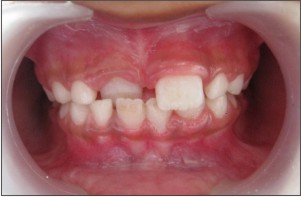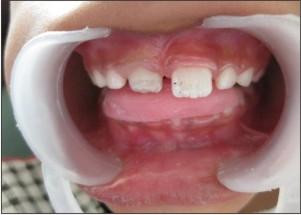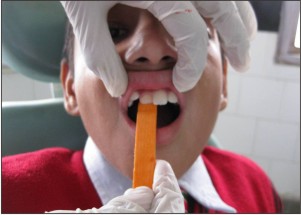Introduction
Well-aligned teeth not only contribute to the health of the oral cavity and the stomatognathic system but also influence the personality of the person[1]. Within the practice environment, pedodontist are the first to examine and screen children for developing malocclusions. Among numerous dental abnormalities, anterior crossbite is a major esthetic and functional concern to the parents during the developmental stage of a child. It is one of the major responsibilities of pediatric dentist or orthodontist to guide the developing dentition to a state of normalcy in line with the stage of oral-facial growth and development[2]. Anterior dental crossbite has a reported incidence of 4- 5% and usually becomes evident during the early mixed dentition phase. [3]
According toAmerican Association of Orthodontists Glossary, crossbite is an abnormal relationship of a tooth or teethto the opposing teeth, in which normalbuccolingual or labiolingual relationshipsare reversed.
The rate of self-correction of crossbites is too low to justify without intervention. An old saying in orthodontics states “The best time to treat a cross bite is the first time it is seen”.[1] Early cross-bite corrections lead to a stable and normal occlusion pattern and contribute to symmetrical condyle growth, harmonious TMJ, and overall growth in the mandible. Few of the choices available for crossbite corrections are Catalans appliance, tongue blade therapy, expansion appliance, cross elastics etc.[1]
Henceforth, this paper documents two cases in which anterior dental crossbite was successfully corrected during developing dentition using a simple fixed Catlan’s appliance and tongue blade therapy.
Case Report
Both the cases reported here were in the early mixed dentition period and had Class-1 molar and canine relationship. There was sufficient mesiodistal distance available in both the cases to achieve labial movement of maxillary tooth.
Case 1
An 8-year-old female patient was reported to the pediatric dental department with a chief complaint of unaesthetic appearance of the front tooth. The medical and dental histories were non-contributory. Intraoral examination showed that the lingually deflected maxillary right central incisor (Fig 1). The diagnosis was a single tooth dental type anterior crossbite. Initially in this case, tongue blade therapy was given. But due to poor patient compliance and unable to perform tongue blade therapy according to instructions given, the patient reported without any change after 7 days (Fig 2a and 2b). So to treat the dental crossbite, lower anterior inclined plane (catlan’s appliance) was planed. Parents were informed about the treatment, and a written consent was documented. Alginate impressions of both arches were made, and an acrylic inclined plane with a slope of 45 degree angulations to the long axis of the tooth was established. The inclined plane was cemented on to the mandibular incisors and canines with zinc oxide eugenol cement (Fig 3a and 3b). After the cementation of the inclined plane, the only contact point was present at the incisor region in state of occlusion. The patient was advised to maintain good oral hygiene and recalled every week to clinically evaluate the progress of the treatment. The patient was advised for a softer diet than usual for the first few days after the cementation. The inclined plane produced a forward sliding motion of the maxillary incisors on closure and an anterior crossbite correction was seen within 2 weeks itself (Fig 4). No post- operative sensitivity or pain was reported by the patient. Following correction, the Catlan’s appliance was removed, the enamel surface was polished, and topical fluoride (APF gel) was applied.
 | Fig I: Single Tooth Anterior Crossbite
 |
 | Fig IIa:Tongue Blade Therapy Explained To Patient
 |
 | Fig IIb: Patient Returned With No Improvement After 7 Days
 |
 | Fig IIIa :Catlan’s Appliance Constructed
 |
 | Fig IIIb: Catlan’s Appliance Cemented With Zinc Oxide Eugenol
 |
 | Fig IV:Correction Of Crossbite
 |
Case 2
A 9 year old male patient reported to the pediatric dental department with the chief complaint of pain and mobility in lower front tooth. The medical and dental histories were non-contributory. Intraorally, it was observed that the maxillary right permanent central incisor(11) was lingually locked and gingival recession was seen in relation to 41(Fig 5). As 11 was in erupting stage tongue blade therapy was explained to the patient. The patient was instructed to insert the tongue blade at an angle between the teeth and he was asked to bite firmly for five seconds followed by rest. This is repeated for 25 times for three times a day (Fig 6). The patient was recalled after every one week and the crossbite was corrected within 15 days (Fig 7). In this particular case as the patient’s compliance was good, the desired results were obtained with tongue blade only and no appliance was required further. The patient did not complain of any pain or inflammation postoperatively and was satisfied.
 | Fig V: Lingually Deflected 11 And Gingival Recession W.R.T 41
 |
 | Fig VI: Tongue Blade Therapy Demonstrated
 |
 | Fig VII: Correction Of Anterior Crosssbite
 |
Discussion
Anterior crossbite isthe lingual positioning of the maxillary anterior teeth inrelationship to the mandibular anterior teeth. This may involve a single tooth or all four incisors.A variety of factors reported to cause anterior dental crossbite, include a palatal eruption path of the maxillary anterior incisors; trauma to the primary incisor resulting in lingual displacement of the permanent tooth germ; supernumerary anterior teeth; an over-retained deciduous tooth; odontomas; inadequate arch length; and a habit of biting the upper lip.[3].
There are many treatment options available for correction of crossbites according to the number and site of the teeth/tooth involved, the stage of the dentition and its etiology. The main goal of treatment is to tip the affected maxillary tooth or teeth labially to the point where a stable overbite relationship exists to prevent abnormal enamel abrasions, fractures of anterior teeth, periodontal pathosis, and to produce a more esthetic dentofacial complex and a better occlusion. Relapse is usually prevented by the normal overjet/overbite relationship that is achieved [2].
The tongue blade is an effective method of treatment during the early phase of eruption, however, it requires total co-operation from the patient, which could not be achieved in first case. The Catlan’s appliance works on the principle of Newton’s third law of motion, the resin slope functions to tip an anterior tooth labially while the mandibular tooth is tipped slightly in the lingual direction. This method is a safe, cost effective, rapid and easy alternative for the treatment of crossbite. As it is cemented on the incisors, the treatment outcome does not depend on patient cooperation, does not hamper the growth or cause any discomfort to the patient, and treatment is completed in very few visits to the dentist [2].
Conclusion
It should be emphasized that it is very important to correct crossbites at an early age, reducing the need for long term orthodontic therapy in the future, justifying the saying “The best time to treat a cross bite is the first time it is seen”.
References
1. Koshy Philip. Interceptive Orthodontics – Why? When? Where?. Journal of Clinical Dentistry2011;2(1):36-38
2. Prashanth Prakash and B. H. Durgesh. Anterior Crossbite Correction in EarlyMixed Dentition Period Using Catlan’s Appliance: A Case Report.ISRN Dentistry 2011.
3. Syed Mohammed Yaseen and Ravindranath Acharya. Hexa Helix:Modified Quad Helix Appliance to Correct Anterior and Posterior Crossbites in Mixed Dentition.Case Reports in Dentistry 2012.
4. S. Bayrak and E. S. Tunc. Treatment of anterior dental crossbite using bonded resin-composite slopes: case reports. European Journal of Dentistry 2008; 2: 303–307.
5. Jirgensone, A. Liepa, and A. Abeltins. Anterior crossbite correction in primary and mixed dentition with removable inclined plane (Bruckl appliance). Stomatologija 2008;10( 4):140–144.
6. German Ramirez-Yañez. Treatment of Anterior Crossbite in the Primary Dentition With Esthetic Crowns: Report of 3 Cases. Pediatric Dentistry 2011;33 (04)
7. Sanjay Chachra , Preety Chaudhry. Comparison of Two Approaches for the Treatment of Anterior Cross Bite. Indian Journal of Dental Sciences.
8. Andrew Dibiase. The Timing of Orthodontic Treatment.Dent Update 2002; 29: 434–441.
9. Felicity Borrie and David Beam.Early correction of anterior crossbites: a systematic review.Journal of Orthodontiis. 2011;38: 175 184.
10. Jae Hyun Park, Tae Weon Kim. Anterior Crossbite Correction with a Series of Clear Removable Appliances: A Case Report.J Esthet Restor Dent 2009;21:149–160.
|